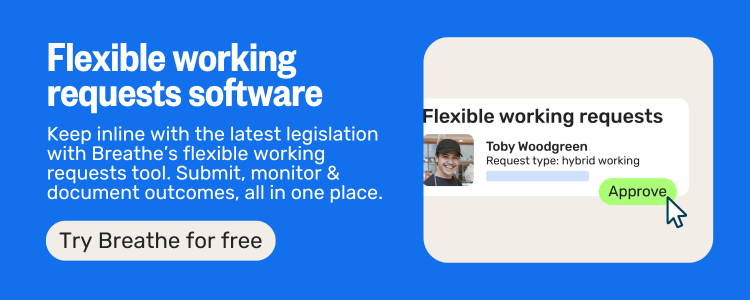If your employees sometimes need to put in extra hours, offering time off in lieu (TOIL) can be a smart and fair way to say thank you.
It's a way to help manage costs while also supporting employees in maintaining a healthy work-life balance. TOIL can also help prevent burnout by giving your team time to rest and recharge.
Many employers, especially those in shift-based or busy industries, use TOIL as an alternative to overtime pay. TOIL is often used when employees are working overtime, particularly during busy or peak periods.
This approach can be a valuable tool for managing situations where additional hours are needed, and it contributes to a better work-life balance for employees. Done right, this gives you some flexibility to adapt to seasonal demand by reassigning time off to less busy business periods.
At first glance, TOIL might sound simple: if someone works three hours over, they take three hours off later. But the reality can be more nuanced, especially in seasonal businesses, where workloads rise and fall throughout the year.
In this blog, we’ll look at how time off in lieu works and the common problems that arise, as well as offering some tips on how to manage it effectively.
Skip to:
What is time off in lieu (TOIL)?
4 steps for effective TOIL management
Annual leave and TOIL: What's the difference?
How to keep TOIL on track and protect work-life balance
What is time off in lieu (TOIL)?
Employee paid time off in lieu (TOIL) is the practice of offering extra paid leave to employees who work overtime. This can often be done instead of offering overtime payment.
There’s no legal requirement in the UK to offer TOIL, which means you’ve got the flexibility to shape a policy that works for your business. But that also makes it even more important to be clear on how it’s used.
Ideally, your TOIL policy should be written down, either in your employment contracts or a staff handbook, so everyone knows where they stand. This includes how TOIL is earned, tracked, and taken. While it’s possible to manage TOIL informally, a written policy helps avoid confusion and sets clear expectations for both you and your team.
It’s also a good idea to enforce an expiry date for accumulated TOIL leave. The most obvious expiry date would be the end of the month, calendar year or financial year.
That said, there’s always room for flexibility. If a one-off situation crops up, you can still make individual arrangements outside your usual policy.
Read more: The price of unused holiday: December’s hidden cost
How does TOIL work?
TOIL is accrued when an employee works extra hours beyond their contracted time. For every additional hour worked; they accrue time off that can be taken later.
Employers should keep a clear record of these hours - ideally using HR software or a timesheet system - and ensure TOIL is approved in advance by a manager. Once earned, TOIL can be booked in the same way as annual leave, with approval required to avoid during busy periods.
A good rule of thumb is that TOIL should be taken within one month of being earned, though managers can extend this up to 12 months in some cases. This helps prevent a build-up of unused hours.
The benefits of TOIL
Time off in lieu (TOIL) can be a win-win for both your business and your people, especially during busy periods when extra hours are hard to avoid.
Many employees value time, even more than money. Whether it’s to rest, look after personal commitments or simply take a breather, TOIL helps people recharge in a way that suits them. That flexibility goes a long way in supporting wellbeing and preventing burnout.
For employers, TOIL is a practical and cost-effective way to manage extra hours, helping you respond to seasonal peaks without the added pressure of overtime pay. It’s also a clear way to show your team that you value their time and their wellbeing, which can help boost morale, engagement, and retention.
Handled well, TOIL can help build a healthier workplace culture, one where people feel supported and the business stays agile.
Legal requirements of toil
As there isn't a legal requirement in the UK to offer time off in lieu, if you do, it’s important to make sure your policy is legally sound.
Any TOIL policy needs to comply with employment law, including the EU Working Time Directive. This sets limits on weekly working hours and outlines the minimum rest breaks and paid annual leave employees are entitled to. So even when your team works extra hours and earns TOIL, they can't exceed legal limits on working hours and their statutory annual leave still needs to be protected.
It’s also essential to keep things fair. Your TOIL policy should be applied fairly to everyone - including part-time, casual and other staff. Be clear about how TOIL is earned, how it can be used, and any restrictions, so everyone knows where they stand.
Additionally, employers should remember that regular or compulsory overtime may count as ‘normal pay’ when calculating the first four weeks of statutory holiday entitlement. This ensures accuracy in payroll and avoids underpayment risks.
Employers must also ensure that any unpaid extra hours worked do not reduce an employee’s average hourly pay below the National Minimum Wage threshold.
Getting this right helps you stay compliant, but it also shows your people that you’re committed to a fair and supportive workplace.
TOIL vs overtime pay
| Aspect | TOIL | Overtime |
| Purpose | Reward for extra hours with time off | Reward for extra hours with pay |
| When to use | When budgets are tight or work-life balance is prioritised | When immediate labour compensation is preferred |
| Benefit to employees | Rest and recovery time | Increased take-home pay |
| Benefit to employers | Cost control and flexibility | Simpler payroll management |
| Ideal for | Seasonal or project-based work | High-demand or time-sensitive operations |
TOIL policy example
A clear TOIL policy helps keep things fair and compliant. Here’s a sample outline employers could adopt:
- Accrual rate: Standard Monday–Friday hours accrue TOIL at 1:1.
- Enhanced accrual: Saturdays may accrue at 1.5x, Sundays and Bank Holidays at 2x, if enhanced rates are offered.
- Expiry rule: TOIL should be taken within one month of being earned but can be extended up to 12 months with line manager approval.
- Approval: All TOIL must be pre-approved and recorded via HR software or timesheet systems.
- Fairness for part-time staff: TOIL should apply pro-rata to avoid indirect discrimination and ensure that part-time staff are treated fairly and consistently.
- Record keeping: Accurate records must be maintained for audit and payroll purposes.
And remember, TOIL should never bring an employee's average hourly pay below the National Minimum Wage during a pay reference period.
4 steps for effective TOIL management
Managing TOIL can be a challenge, but it doesn’t have to be.
For many employers, keeping on top of TOIL is where things get tricky. It’s easy to lose track of who’s worked extra hours and how much time off they've earned. That's why it's important to manage it properly - to keep things fair and clear.
That’s where your HR team comes in. They play a key role in making sure TOIL is logged accurately and policies are followed consistently.
To manage it smoothly, you’ll need a clear system that shows which employees have worked overtime and how much leave they’ve built up. Without that, things can quickly get messy.
Here are some practical tips to help you manage TOIL more effectively:
1. Check if TOIL is right for your team
Is TOIL right for your team?
When someone works extra hours, there’s more than one way to recognise their time. Some businesses offer paid overtime, while others provide time off in lieu (TOIL). Both can work well. It just depends on what’s right for your team and your budget.
Some employees might prefer to be paid for overtime. Others may value the flexibility of taking time off instead. If your budget allows, you could even offer enhanced rates, like time-and-a-half, as a way to say thanks.
Whatever approach you choose, it’s worth talking to your team before setting a policy. Listening to what matters most to them helps build a fairer and more supportive workplace.
There’s no legal requirement to pay for extra hours worked, but recognising when your people go the extra mile is simply good practice. If TOIL isn’t the right fit, you might consider other ways to show appreciation, like bonuses, extra benefits, or additional pay.
2. Be clear about how TOIL works
If you're going to offer TOIL, it's important to be clear on the rules from the start. Creating a policy and setting expectations helps everyone understand what's fair and prevents confusion down the line. Here's what you should consider when creating a TOIL policy:
- What counts as overtime: Define what you mean by 'extra hours' (e.g. anything beyond contracted hours), and when TOIL kicks in.
- How TOIL is calculated: Explain how extra hours are converted into time off.
- Minimum thresholds: If there's a minimum number of extra hours required to qualify for TOIL, make that clear.
- Policy compliance: Make sure TOIL is managed in line with both employment law and your own internal processes.
- Tracking TOIL: Keep accurate records to keep things fair and transparent, and to avoid TOIL becoming the default for regular overtime.
- Approval process: Be clear on who approves overtime and TOIL. This is usually the employee's line manager.
- Time limits: Set a clear deadline for when TOIL must be used (for example, within the month or before the end of the financial year).
- Using TOIL as holiday: Confirm that TOIL can be used like holiday leave, giving employees added flexibility.
- Distinguish from flexi time: TOIL and flexible working are separate policies, so it's helpful to clearly outline the difference.
- Monitor excess hours: Keep an eye on overtime patterns to help protect wellbeing and avoid business disruption.
- When TOIL is most useful: Highlight that it can be particularly helpful during short-term projects or busy seasonal periods.
3. Put TOIL terms in writing
When it comes to TOIL, clarity really matters. If the rules aren’t clearly set out, they can end up being applied inconsistently, leading to confusion or even feelings of unfairness among your team.
That’s why it’s a good idea to document your TOIL policy in writing. It doesn’t have to be part of the employment contract, but having something written down helps make sure everyone knows where they stand.
For any one-off TOIL arrangements that sit outside your main policy, it’s still worth noting them down. This keeps things transparent and avoids any misunderstandings later.
In fact, keeping TOIL out of the employment contract can sometimes make sense. It gives you the flexibility to adapt your policy as your business changes, without needing to renegotiate terms.
4. Set clear guidelines for when TOIL can be taken
As with any kind of time off, it helps to be clear about when TOIL can and can’t be used. This keeps things fair and helps avoid disruption to your team.
Employees should follow the usual process for requesting time off, so TOIL can be managed alongside annual leave and other absences. This helps ensure you don't end up short-staffed during busy times.
You might choose to create separate rules for TOIL, or you could simply follow your existing holiday policy. Whatever you decide, the most important thing is that everyone knows what's expected. That way, you reduce the risk of confusion and keep things running smoothly for the whole team.
Calculating TOIL accurately
Getting TOIL calculations right is key to making sure your people get the time off they’ve earned.
Start by setting up a clear system for recording extra hours worked, including overtime hours, and track how much TOIL each person has built up.
It’s also helpful to set an expiry date for TOIL, whether that’s the end of the leave year, the financial year, or another agreed time. This helps keep things simple and avoids any last-minute rushes.
To make the process easier, you might want to set a minimum increment for recording TOIL, like half an hour or an hour, so you’re not juggling tiny bits of time.
Using HR software like Breathe, and a reliable time tracking tool can take a lot of the hassle out of managing TOIL. It helps reduce the risk of errors, cuts down admin, and gives you a clear picture of what’s been worked and what’s owed.
Enhanced accrual examples can also make policies clearer. For instance, standard weekday overtime could accrue at 1:1, Saturdays at 1.5x, and Sundays or Bank Holidays at 2x. This helps keep things fair and clear for everyone across your workforce.
Accurate records and simple systems don’t just help you stay organised - they also support a fairer, healthier approach to work-life balance for your team.
Annual leave and TOIL: What's the difference?
Both annual leave and TOIL give employees paid time off. But they’re not quite the same.
Annual leave is a core part of every employment contract. TOIL, on the other hand, is earned by working extra hours. While some employers choose to roll TOIL into an employee’s overall leave balance, others keep it separate. There’s no right or wrong. What matters is having a clear policy so your team knows how their time off works.
It’s also worth setting out how TOIL and annual leave work together. For example, does taking TOIL affect how much holiday someone can carry over? Are there different expiry dates for each?
By making these details easy to understand, you’ll help your people make the most of their time off and keep things fair and compliant for your business.
How to keep TOIL on track and protect work-life balance
There are always going to be times in your business when you need staff to work extra hours. Sometimes, a sudden drop in staff due to sickness means the only solution is to ask staff to stay late and cover the work.
But without the right approach, TOIL can sometimes cause issues. For example:
- Confusion over the rules
- TOIL being used in the wrong way
- Staff feeling pressured to work extra hours
- Too many untaken TOIL hours creating business risk
- Disagreements about leave entitlement or leave allowances
Sometimes, frequent overtime can even be a sign of deeper issues, like workload imbalances, staffing gaps, or unclear priorities.
Most of these problems can be avoided with a clear, well-communicated TOIL policy. But that’s just the starting point. It’s also important to understand why extra hours are happening in the first place. Are people regularly staying late because they’re stretched too thin? Is presenteeism creeping in? Are processes getting in the way of productivity?
And sometimes, habits like “waiting around after work” or logging extra hours unnecessarily can point to a need for better team communication or support.
That’s why it helps to keep track of who's taking TOIL, when and why. With visibility, you can spot habits early and step in before they become the norm.
Supporting your team with training, better planning, or extra resources can reduce the need for regular overtime. When TOIL is managed well, it helps everyone find a better balance, giving both managers and employees back valuable time.
Don't toil over time tracking
It’s not always easy for managers to keep track of who’s worked extra hours and when TOIL is being taken. But accurate time tracking is essential. It’s what makes TOIL fair, compliant, and manageable for everyone.
The best way to stay on top of it? A single, reliable HR system that brings together hours, overtime, holiday, and TOIL in one place. Manual processes often lead to mistakes, confusion and extra admin and that’s time no one wants to lose.
That’s where Breathe’s Rota, Time & Attendance add-on comes in. It helps you log overtime, track TOIL, and calculate what’s owed, all from a central dashboard.
FAQs
Q: What is TOIL and how does it work?
A: TOIL (Time Off in Lieu) is paid time off given instead of overtime pay when an employee works extra hours. For example, if someone works two hours over, they can take two hours off later. It’s a flexible way to reward staff, manage peak workloads, and support work-life balance, especially when managed with a clear, written policy.
Q: Is TOIL a legal requirement in the UK?
A: No, TOIL isn’t legally required. But if you offer it, your policy must comply with UK working time laws, like limits on weekly hours and ensuring rest breaks and statutory leave aren’t compromised.
Q: How is TOIL different from annual leave?
A: Annual leave is a legal entitlement, while TOIL is earned through overtime. Some businesses combine them in one leave balance, others keep them separate; what matters is being clear with your team on how each is tracked and used.
Q: What are the benefits of offering TOIL?
A: TOIL gives employees valued flexibility and helps prevent burnout. For employers, it’s a cost-effective alternative to overtime pay that shows appreciation, boosts morale, and helps manage seasonal demands.
Q: How do you calculate and track TOIL accurately?
A: Track actual overtime worked and convert it directly into TOIL using a consistent method. Set expiry dates to avoid stockpiling, and use HR software like Breathe to streamline logging, approvals, and visibility.
.webp)
Author: Sarah Benstead
Sarah is a Product Marketing Specialist here at Breathe. Always innovating, she loves writing about product releases in an engaging & informative way. When she's not coming up with new ideas, she enjoys long walks with her dog, Clifford.





.webp)

